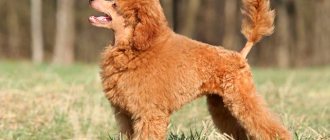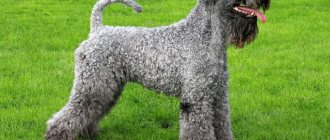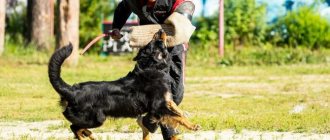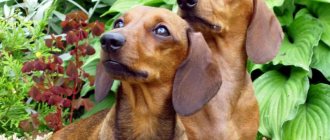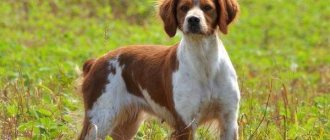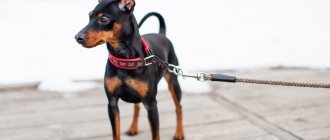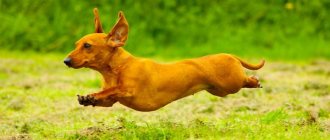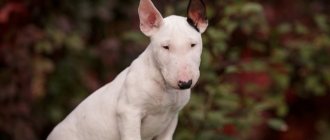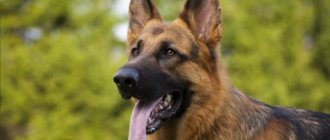/ Dogs / Dog breeds / Description of the Royal Poodle breed
0
3210
Article rating
The Great Royal Poodle is a French breed of toy dog whose ancestors are considered to be French hunting water dogs. A distinctive feature of the breed is its large size, as these dogs are much larger than other poodles. According to research by psychology professor Stanley Coren, poodles are one of the smartest dogs in the world. In Koren's ranking (described in the book “Dog Intelligence” of 1994), they take an honorable 2nd place due to their quick learning, excellent memory and gentle nature. The first place in the ranking is occupied by the Border Collie breed.
Great Royal Poodle
History of the breed
There is no reliable information about the place and time of the birth of the breed. However, it is certain that dogs resembling modern poodles existed in ancient times.
One version says that the birthplace of poodles is Germany. This theory is associated with the name of the breed, which is translated from German as “waterfowl”.
Another theory, which most scientists adhere to, says that poodles originated in France. This version is confirmed by the fact that the large (royal) poodle is the national breed of the country.
There is also debate about the ancestors of the breed. Some scientists say that poodles descended from divers and European herding dogs, others claim that their ancestors were barbets.
NOTE!
Initially, poodles were used to hunt water birds, and only representatives of the upper classes were allowed to keep and breed these dogs.
The first breed standard was established in the 17th century, so the rich history of the breed is not just words.
Historical reference
According to the generally accepted version, Poodles moved to Europe from the territory of ancient Greece. Historians do not undertake to confirm the authenticity of this data, since the dogs went through serious breeding work. To improve their hunting qualities, curly dogs were taken with spaniels, pointers and other gun dogs. It is reliably known that the greatest contribution to the development of the breed was made by breeders from France and Germany.
The struggle for ownership of Poodles lasted for years, but according to the rules of the FCI (Federation Cynologique Internationale), patronage is assigned to only one country. Germany could not stand the race and withdrew its claims. A French description of the breed, literally translated into English, was included in the international register. Since the standard remains unchanged, the “laced” poodle is also included in it. In fact, the fashion for lacing wool began in the middle of the 20th century.
Modern Poodles are considered as a decorative and companion breed. Many owners do not even know that their pets have well-developed hunting qualities and, with appropriate training, will be able to work with ducks. However, no one doubts the mental abilities of Poodles; dogs are trained in absolutely any sport and discipline. It is also known that Royal Poodles were trained in sports riding (sleigh riding).
Description and standard
Royal Poodles are large, noble dogs with a harmonious, proportional build and a massive, but not heavy body.
The Official Standard for the Large Poodle describes them as follows:
- the head looks harmonious, the occipital protuberance is moderately massive, the forehead is not too protruding;
- the transition from the forehead to the muzzle is smoothed, the bridge of the nose is straight;
- lips of medium thickness, tightly fitting, the outer line is completely colored;
- the teeth are medium, white, straight, scissor bite;
- the eyes are small, almond-shaped, set straight;
- the ears are hanging, close to the muzzle, the ends are rounded;
- the body is rectangular in format, the body is muscular, the skin fits tightly, no folds are formed;
- the chest is deep, oval;
- the back is straight, the croup is slightly rounded;
- the paws are straight, even, the pads are small, oval.
As for the tail, the standard allows for both docking and natural length.
Breed standard
The Royal Poodle is the tallest representative in the breed group. These are proportionally built animals, which, despite their rather large size, are very graceful and elegant.
The head is medium in size, in harmony with the body, oval-shaped, the skull is slightly convex at the top. Smooth transition from nose to forehead, weak stop. The nasal lobe is well developed, with large nostril openings, convex, voluminous. The color depends on the coat.
The muzzle is elongated, straight, strong. Lips are dry, without jowls, of medium density. The upper lip covers the lower one, however, not completely. The teeth are strong, scissor bite. Any deviation in the bite is considered a disqualifying sign.
The eyes are medium-sized, almond-shaped, slightly slanted. The look is attentive, focused and intelligent.
The ears are long, hanging, wider at the bottom, the tips are rounded, well covered with fur.
The neck is elastic, in the form of a small arc, high. Thanks to her, the poodle proudly and slightly carries his head.
The body is proportional, the withers are clearly defined. The back is short, the lumbar region is strong and muscular. The croup is rounded. The chest is wide and deep, descending to the elbow joints. The belly is tucked up like a greyhound.
The tail is located high on the croup, of medium thickness, raised up. The limbs are straight, set parallel, the paws are rounded, gathered into a tight fist. Running free, dancing, smooth.
The animals have pronounced sexual dimorphism, males are large and powerful, females are graceful and graceful.
The coat can be corded or curly. The first variation is slightly wavy, soft to the touch, up to 20 cm long. The second is elastic, with good curls, forming curls.
Acceptable colors : all solid colors (white, black, silver, brown, red, apricot). Any blotches on the main color are considered disqualifying.
Character traits
Royal poodles have a cheerful, playful character. These are cheerful dogs who love active walks and games.
They need the owner’s constant attention, care and communication, and strive to spend maximum time with him, sometimes being too intrusive. Thanks to their innate powers of observation and excellent memory, representatives of this breed are able to instantly notice any changes in the behavior and mood of the owner and instantly adapt to them.
Large poodles are intelligent and quick-witted, making them quite easy to train. The main thing when training a dog is to show leadership qualities and perseverance, otherwise the pet will be cunning and evade classes. It is necessary to start raising a dog from early childhood; without proper training, a poodle will grow up willful, capricious and disobedient.
They are wary of strangers, always ready to rush to the owner’s defense, but do not show aggression - such behavior is not typical for them.
IMPORTANT!
Before purchasing a Royal Poodle, it is important to think seriously and evaluate your strengths. These dogs need a lot of time, they cannot be alone and need the company of their owner.
In addition, they require labor-intensive and expensive care, which should also be taken into account. If none of this makes you change your mind, you can safely buy a puppy - a cheerful, active, cheerful pet will be devoted to its owner all its life and will give many positive emotions.
Education and training
The poodle is endowed with a high level of intelligence, which allows him to quickly absorb information and accurately carry out everything that is asked of him. They are able to master not only the basic course, but also a more complex program. Along with this, the dog’s excessive intelligence can become a serious test for its owner, as the animal can begin to be cunning and show unprecedented stubbornness. To prevent this from happening, it is important to initially gain the pet’s trust and only then begin training.
Since the dog is very attached to its owner, it will gladly do anything just to be always close to its owner. In principle, for fruitful upbringing it is enough just to encourage your four-legged friend with good words; as an additional bonus, you can give out a treat.
If you use the “carrot and stick” method in the training process, there will be no result. These dogs categorically cannot tolerate assault, swearing, or excessively raising the tone. Only polite and patient treatment will bear fruit, because after all, this is a representative of royal blood.
If the animal will attend exhibitions in the future, then training should begin as early as possible, from about 4 months. The dog must learn to stand, run correctly in the ring and not be distracted by other dogs. In addition, she must get used to the fact that strangers will examine her.
Advantages and disadvantages
The grace and aristocracy that emanate from royal poodles, and their attractive and impressive exterior in general, are far from the only advantages of these dogs.
The advantages of representatives of this breed are also:
- cheerfulness;
- cheerful character;
- devotion;
- endurance;
- intelligence and intelligence;
- lack of aggression;
- security qualities;
- lack of specific odor and shedding.
NOTE!
In addition, these dogs get along well with other pets, get along well with children, and their fur does not provoke allergic reactions.
Disadvantages of the breed:
- irritability;
- wary attitude towards strangers;
- the need for constant attention;
- need for long and active walks;
- inability to be alone;
- difficult care.
Large poodles are also noted for their tendency to bark loudly, often without cause.
Advantages and disadvantages
The Great Royal Poodle is considered a universal species of all existing dogs on the planet. Its amazing ability to adapt to the habits and rhythm of its owner has acquired and continues to acquire legends. No one wants to dispute the fact that dogs are perfectly obedient. Their good nature extends even to offenders.
The dog doesn't know how to bite. She can bite a hand, but not bite seriously - such is the great respect for a person that has developed over centuries. It is not for nothing that the breed is considered to be the most intelligent of all existing ones.
An obvious advantage of poodles over other breeds is the lack of shedding. Dogs do not have undercoat, which causes allergic reactions in humans during shedding. Therefore, the breed is considered hypoallergenic.
Many people reject the idea that poodles have flaws. They consider the only disadvantage to be that their pets do not have eternal life, and the disadvantage is how much a royal poodle costs.
However, poodles do have disadvantages. In some cases, destructive behavior is observed during a long absence of the owner - dogs bark, howl, and damage property.
They only stop acting up when the owner returns.
A disadvantage is the boundless gullibility of strangers. And one more quality, assessed in equal parts as an advantage and a disadvantage - large royal poodles do not know how to take offense at a person.
Photos of colors
According to the FCI system, there are 6 standard coat colors for large poodles. The main condition for compliance with the standard is that the color must be uniform, without transitions of shades or inclusions of other colors.
Black
Black is the most common color of poodles.
Black wool, in comparison with other colors, is considered the highest quality. To meet the standard, the black color must be bright, rich, different in depth and intensity. An admixture of other shades or tints of other colors are unacceptable.
White
Newborn puppies may have yellowish spots on the chest, ears, and bottom of the paws, but as they grow older they disappear. Puppies are also allowed pink pigmentation on their nose and paw pads, which will darken over time.
Silver
The coat can be any shade of gray, but there should be no black or white hairs. These poodles are born with black hair, which gradually becomes lighter at 2 months.
Brown
The coat is a rich brown, almost chocolate, color without the presence of light brown and beige shades. As the dog ages, it becomes more patchy.
Apricot
Such poodles are distinguished by their apricot-colored coat, without the presence of dark brown and white hairs. The ears may be slightly richer than the body.
Red (red)
The coat is the color of mahogany, the skin is the same shade.
Attitude towards children and pets
Being sociable and friendly dogs, representatives of this breed easily get along with everyone, especially children. Both are curious, active and love games, so they quickly become friends and spend time together.
The poodle steadfastly endures all the baby’s pranks, allowing itself to be considered a “living toy.” If a child shows excessive importunity or rudeness, although not consciously, the poodle will not get into a fight with him, will not bite or show aggression, he will simply end the game, leave and will avoid the child in the future.
Thanks to their easy-going nature and sociability, these dogs also get along well with other animals, be they dogs, cats, rodents or birds.
Care and maintenance
Caring for a royal poodle is a set of hygiene procedures that must be carried out regularly.
Wool and bathing
It is necessary to comb the coat of puppies daily; for adults, combing 2-3 times a week is enough.
After each walk, you need to wash the dog’s paws and belly; a complete wash using a specialized shampoo appropriate for the type of coat is required 3-4 times a month.
Eyes
Wipe with a cotton pad or napkin twice a week to remove accumulated secretions.
IMPORTANT!
If signs of disease are detected (redness, suppuration, increased lacrimation), it is necessary to show the dog to a veterinarian.
Ears
Regularly clean out any accumulations of wax and make sure that the ear canal does not become overgrown with hair; if necessary, pluck it out with tweezers.
Claws
If the claws do not grind down on their own during walks, they need to be shortened with a guillotine nail clipper 2 times a month. The cut should be filed with a nail file.
Life expectancy and major diseases
The life expectancy of large poodles is 12-16 years, and proper care and suitable living conditions help to extend this period.
It is noteworthy that even with hereditary pathologies or any diseases, these dogs still live 10-12 years. Despite good immunity and good health, representatives of this breed are prone to diseases such as:
- diabetes;
- allergy;
- epilepsy;
- diseases of the cardiovascular system;
- retinal atrophy;
- increased lacrimation;
- deafness;
- otitis;
- dysplasia of the hip and elbow joints;
- glaucoma;
- disruptions in the functioning of the endocrine system;
- otitis;
- allergy;
- bloating;
- volvulus;
- epilepsy;
- hypothyroidism;
- lymphadenitis;
- von Willebrand disease;
- retinal degeneration;
- cataract;
- urolithiasis disease.
It is also not uncommon for adult individuals to experience early baldness and loss of shade saturation.
For routine examinations, you should contact your veterinarian at least 2 times a year.
Diseases
Animals are endowed with a good immune system and fairly good health. However, like other breeds, they are prone to inherited diseases. These include :
- Problems with the spinal column.
- Degenerative myelopathy.
- Intussusception.
- Von Willebrand syndrome.
- Eye problems.
- Lymphadenitis.
- Hypothyroidism.
- Epilepsy.
- Dysplasia.
- Diabetes.
In addition to the above problems, dogs often suffer from ear diseases, complications of which can lead to complete or partial deafness. With age, urolithiasis and dermatological problems may develop. Cryptorchidism is also quite common among the population.
Dimensions and weight
The Royal Poodle is the largest representative of this dog breed.
The period of active growth of royal poodles lasts up to approximately 10 months, then up to 1.5 years they continue to develop and form.
The table below shows the size of the Royal Poodle depending on the gender of the dog:
| Floor | Height at withers, cm | Weight, kg |
| Male | 44-62 | 19-25 |
| Bitch | 42-55 | 18-23 |
How and what to feed?
Each owner decides for himself what to feed his pet. These can be natural products or industrial feeds, the main thing is not to mix both types of food and make sure that the diet is balanced and contains all the necessary nutrients, vitamins and minerals.
If the choice falls on natural feeding, the royal poodle’s diet must include:
- lean meat;
- offal;
- sea fish;
- buckwheat and rice cereals;
- fruits vegetables;
- dairy products;
- eggs.
You should add a few drops of sunflower or olive oil to porridge - this is a source of vitamins and fatty acids.
It is strictly forbidden to feed representatives of this breed:
- fatty meat;
- smoked meats, sausages;
- river fish;
- grapes, raisins;
- nuts;
- chocolate and other sweets;
- rich pastries;
- garlic, onions;
- spicy, fried food;
- seasonings, marinades, pickles;
- carbonated drinks;
- legumes;
- mushrooms;
- tubular bones;
- products containing oxalic acid.
You should also not give your dog food from the common table, tea, coffee, or alcohol.
When choosing industrial food as the basis for a poodle’s diet, preference should be given to premium, super premium or holistic food. Such brands as Acana, Eukanuba, Orijen, Royal Canin, Purina Pro Plan have proven themselves well.
How do puppies look and develop?
Like puppies of other breeds, Royal Poodles are born blind and deaf. 12-15 days after birth, their eyes and ear canals open, teeth appear on the 25th day, and by a month they are already leading a completely active life.
Both black and silver poodles are born with black fur. In the second, at 6-8 weeks the coat begins to change color and only then can one judge how the puppy will grow up.
A white representative of the breed usually has a slight yellowish tint at birth - this is normal, over time the dog will become completely white.
Health and treatment
Representatives of this breed are stronger and more resilient than many, but still they are also prone to various infections and diseases.
Common problems include:
- plague;
- rabies;
- hypovitaminosis;
- obesity.
Symptoms that indicate a health problem:
- the dog is lethargic;
- sedentary;
- does not respond to the owner and environment;
- refuses food.
If the dog owner notices one of the manifestations of these symptoms, it is recommended to contact a veterinarian who will make the correct diagnosis and prescribe adequate treatment.
Types of haircuts
The breed standard approves 3 types of haircuts with which the dog will be allowed to participate in the exhibition:
- for a lion - cut the hair on the hind legs and body to the ribs, cut the muzzle from above and below to the eyes and on the cheeks, leave the mustache, a “pompom” of wool remains on the legs below and the tip of the tail;
- English strict - the front part of the body resembles a “lion” haircut, but in the area of the croup, in the groin and on the lower back, hair 1-2 cm long is retained; the muzzle, throat and front paws are shaved with a machine, leaving “pom-poms” below, hair on the head, the withers and nape are not cut;
- modern - during grooming they leave a lot of hair on the body, except for the paws and muzzle.
Other types of haircuts, such as kennel, Dutch, bichon, etc., are not allowed by the standard. However, if the pet does not apply for participation in exhibitions, you can choose any image for it.
And this is what an uncut royal poodle looks like:
How to cut your own hair?
Instructions for cutting a poodle in a lion style:
- fix the dog on the table in a standing position;
- remove hair from the cheeks, bridge of the nose, jaws and ⅔ of the neck with a machine;
- cut off the fur on the front legs, leaving only “pom-poms” in the pastern area;
- repeat the same with the hind legs;
- remove hair from the entire body to the chest;
- trim the fur on the belly and groin;
- remove the hair on the tail, leaving a “pompom” at the tip.
After this, the dog needs to be washed, dried with a hairdryer and combed. Then shape the resulting “vest”, “pom-poms”, “hat” and ears.
If this is your poodle's first time grooming and he is not familiar with clippers and scissors, you should ask for help holding the dog.
How to choose a puppy? Boy or girl?
Before buying a puppy, you need to carefully inspect it. Signs of a healthy dog that meets the breed standard:
- there is no increased lacrimation, eyes without redness;
- the ears are clean and do not emit an unpleasant odor;
- no rash, redness, irritation;
- scissor bite;
- no dandruff or bald patches;
- the lips are black or colored the color of the fur.
The puppy should behave actively, show curiosity, not be afraid of strangers and not show aggression.
Royal poodle females are calmer and more docile, they are more patient and more attached to their owner. Males have a more capricious character, they are more stubborn and need more frequent and longer walks. If you have plans for a pet's exhibition career, you should purchase a male dog if you plan to participate in the breeding of the breed - a female dog.
NOTE!
It is possible to determine what kind of puppy will be - large, medium or dwarf - only after he is 2 months old.
Character and behavior of royal poodles
Large poodles are true artists, cheerful, and audience-loving. Completely people-oriented, sincerely devoted. Good-natured, friendly, moderately affectionate, it may seem that he is absolutely harmless.
Treats children well, is patient, loves playing together. He treats pets with loyalty and no conflict. Unreasonable will not show aggression, but is a leader by nature.
Smart, highly intellectual, requires constant development of his abilities. She loves the learning process and will be happy to participate in professional training and sports activities.
He is very friendly towards strangers, but in a moment of danger he completely changes, becomes aggressive and tries with all his might to protect his family and owner. Brave and courageous. Quite emotional, has a hard time experiencing separation.
Nurseries in Russia and the CIS
Royal Poodles are a popular dog breed, so it is not difficult to find kennels that breed and sell them.
Here are some of them:
- Arwarox, Moscow;
- Atami, Moscow;
- Gently Born, Dolgoprudny;
- Moroshka's, Moscow;
- “Free Wind”, Samara;
- “From Mrs. Panina”, Cherepovets;
- “My Solo”, St. Petersburg;
- Danvik, St. Petersburg;
- FANCY TOY, Krivoy Rog, Ukraine;
- FLORIDA-IRIS, Ukraine, Kharkov region;
- GOLDEN BULLET, Ukraine, Makeevka;
- “Ruzhovy Svitanak”, Brest, Belarus;
- BRIDEL, Minsk, Belarus.
Specialized nurseries employ professional breeders and dog handlers who value their reputation, so the risk of purchasing a non-purebred or sick dog is minimal.
Price range
Prices for purebred royal poodles start from 15 thousand rubles, but most likely, such a puppy will not have a pedigree - the lack of documents allows breeders to reduce the cost of dogs.
A puppy with excellent characteristics will cost 20-25 thousand rubles, a show class representative can cost 60 thousand rubles. and more.
Of course, on the market or through an advertisement on the Internet you can find a puppy cheaper - for 5-7 thousand rubles, but there is no guarantee that he is a purebred and healthy representative of the breed.
Life expectancy at home
The average lifespan of a poodle with good maintenance and care is approximately 12-14 years.
Moreover, how long a particular dog will live depends not only on its size variety, but also on its state of health, past illnesses and heredity. Often it is the genetic factor that becomes decisive and influences how long representatives of certain breed lines live.
Important! Contrary to the widespread belief that males live longer than females, gender does not actually affect the lifespan of poodles.
